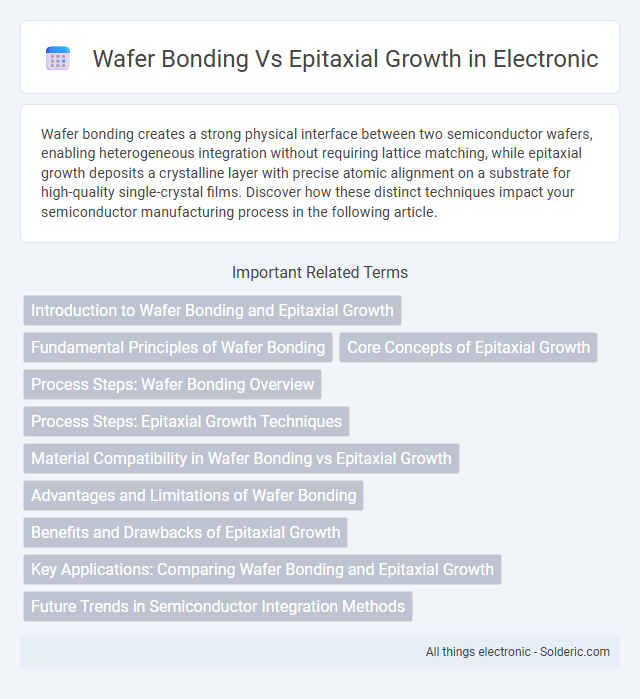Wafer bonding creates a strong physical interface between two semiconductor wafers, enabling heterogeneous integration without requiring lattice matching, while epitaxial growth deposits a crystalline layer with precise atomic alignment on a substrate for high-quality single-crystal films. Discover how these distinct techniques impact your semiconductor manufacturing process in the following article.
Comparison Table
| Aspect | Wafer Bonding | Epitaxial Growth |
|---|---|---|
| Definition | Permanent joining of two semiconductor wafers at atomic level | Deposition of a crystalline layer on a substrate wafer |
| Process | Direct bonding, surface activation, annealing | Chemical vapor deposition (CVD), molecular beam epitaxy (MBE) |
| Material Compatibility | Can bond dissimilar materials (Si to GaAs, Si to SiO2) | Restricted to lattice-matched or closely matched materials |
| Layer Thickness | Typically tens to hundreds of microns (wafer scale) | Nanometer to micrometer scale thin films |
| Applications | 3D integration, MEMS, sensor packaging | Semiconductor device epitaxy, quantum wells, LEDs |
| Advantages | No lattice matching needed, large area bonding | High crystal quality, precise thickness control |
| Limitations | Requires ultra-clean surfaces, possible void formation | Limited to compatible materials, slower process |
Introduction to Wafer Bonding and Epitaxial Growth
Wafer bonding and epitaxial growth are critical semiconductor fabrication techniques used to create advanced microelectronic devices. Wafer bonding involves joining two semiconductor wafers at the atomic level to form a single structure without melting, enabling heterogeneous integration and 3D device architectures. Epitaxial growth refers to the deposition of a crystalline layer on a substrate wafer, maintaining lattice alignment to produce high-quality thin films essential for device performance and material engineering.
Fundamental Principles of Wafer Bonding
Wafer bonding involves the direct joining of two semiconductor wafers at their surfaces through atomic or molecular interactions, forming a strong, defect-free interface without melting. This process relies on surface activation, cleanliness, and precise alignment to achieve high bond strength and electrical continuity. Your choice of wafer bonding can enhance device integration and enable heterogeneous material combinations beyond the limitations of epitaxial growth.
Core Concepts of Epitaxial Growth
Epitaxial growth involves depositing a crystalline layer on a substrate where the deposited layer aligns with the crystal lattice of the underlying material, ensuring high-quality, defect-minimized films essential for semiconductor devices. This process utilizes techniques like Molecular Beam Epitaxy (MBE) and Metal-Organic Chemical Vapor Deposition (MOCVD) to precisely control layer thickness, composition, and doping profiles at the atomic level. Epitaxial growth contrasts with wafer bonding by fostering atomic-level integration between layers rather than physically joining two separate wafers.
Process Steps: Wafer Bonding Overview
Wafer bonding involves aligning and pressing two ultra-flat wafers together, often with a thin intermediate layer to facilitate adhesion and electrical conduction. The process steps include surface preparation such as cleaning and activation, precise alignment, bonding under controlled temperature and pressure conditions, and post-bond annealing to enhance bond strength. Your device performance depends on the quality of the bond interface, which can impact mechanical stability and electrical characteristics.
Process Steps: Epitaxial Growth Techniques
Epitaxial growth techniques involve depositing a crystalline layer on a substrate wafer through methods such as Molecular Beam Epitaxy (MBE), Metal-Organic Chemical Vapor Deposition (MOCVD), and Liquid Phase Epitaxy (LPE). These steps require precise control of temperature, pressure, and gas flow to ensure atomic layer alignment and high-quality crystal formation. You can achieve semiconductor device fabrication with superior electrical properties by optimizing these epitaxial growth process parameters.
Material Compatibility in Wafer Bonding vs Epitaxial Growth
Material compatibility in wafer bonding allows for the joining of dissimilar substrates such as silicon and glass or III-V semiconductors with silicon, enabling heterogeneous integration with fewer lattice constraints. Epitaxial growth demands closely matched lattice constants and thermal expansion coefficients to ensure high-quality crystal layers, limiting material choices primarily to those within the same semiconductor family, such as silicon on silicon or gallium arsenide on gallium arsenide. Your project's material compatibility needs will dictate whether wafer bonding offers greater flexibility for hybrid device fabrication compared to the strict epitaxial growth requirements.
Advantages and Limitations of Wafer Bonding
Wafer bonding offers advantages such as high alignment accuracy, the ability to combine dissimilar materials, and fabrication of complex 3D structures without lattice matching constraints. Its limitations include potential interface contamination, thermal budget restrictions, and challenges in achieving strong bonds with very thin wafers. You can leverage wafer bonding for heterogeneous integration but must consider processing conditions to maintain interface integrity.
Benefits and Drawbacks of Epitaxial Growth
Epitaxial growth offers precise control over layer thickness and composition, enabling high-quality semiconductor structures essential for advanced electronic and optoelectronic devices. Its benefits include improved material uniformity and superior electrical properties compared to wafer bonding, which often faces challenges like interfacial defects and limited lattice matching. However, epitaxial growth is typically more expensive, time-consuming, and requires stringent process conditions, limiting its scalability and versatility in some applications.
Key Applications: Comparing Wafer Bonding and Epitaxial Growth
Wafer bonding is essential in 3D integration, MEMS devices, and heterogeneous material integration, enabling complex multi-layer structures with enhanced functionality. Epitaxial growth is critical for producing high-quality semiconductor layers in optoelectronics, power devices, and advanced transistors, ensuring precise control of crystal quality and thickness. Both techniques are pivotal in semiconductor manufacturing but serve distinct roles: wafer bonding excels in assembling disparate materials, while epitaxial growth focuses on layer deposition with atomic-level precision.
Future Trends in Semiconductor Integration Methods
Wafer bonding and epitaxial growth are advancing toward higher precision and scalability in semiconductor integration, with wafer bonding enabling heterogeneous material combinations for 3D architectures and epitaxial growth improving atomic-level layer control for next-generation devices. Future trends emphasize integrating disparate semiconductor materials like silicon, III-V compounds, and 2D materials to enhance performance and functionality in AI chips, photonics, and power electronics. Innovations in atomic layer deposition, wafer-scale heterogeneous integration, and defect reduction techniques are pivotal for achieving ultra-high density, energy-efficient semiconductor systems.
Wafer Bonding vs Epitaxial Growth Infographic

 solderic.com
solderic.com